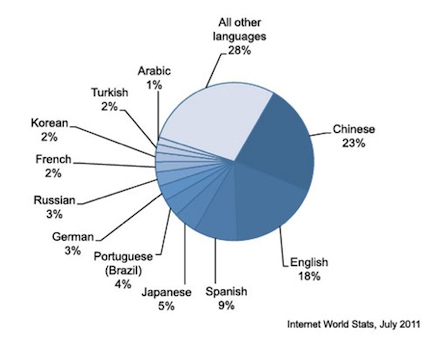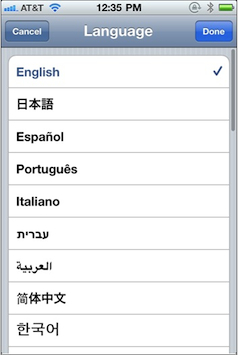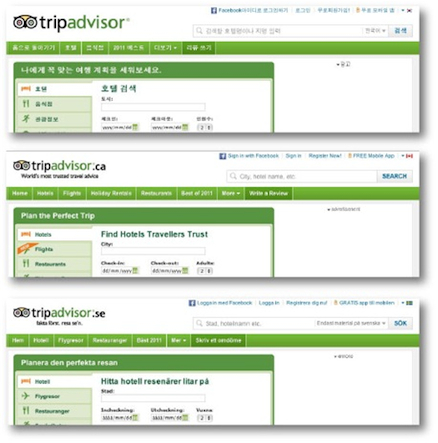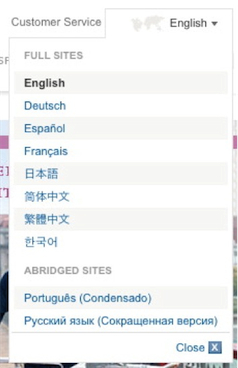Few industries are more global than the travel industry. Not only must travel and hospitality companies serve customers across a large number of countries and languages, they must do so across a wide range of mobile devices.
As a result, many travel companies have invested heavily in globalizing their web and mobile experiences. This article focuses on a few of the leaders and provides lessons for any company planning to serve users around the world.
Balancing Global Aspirations with Local (and Mobile) Requirements
First, it’s important to understand the unique challenges that companies in the travel industry face when taking their websites global.
For starters, few travel websites are “sites” in the conventional sense. The home page of Kayak, for example, is a sophisticated search engine that hides enormous complexity. And the home pages of most airlines and hotels are simply the front door to a mix of software applications, from online reservations, to flight tracking, to e-commerce. Travel websites have more in common with software applications than static websites.
And customers now expect to have access to these software applications across a range of platforms: desktop computers, laptops, tablets, and mobile phones.
Meanwhile, an increasing number of world travelers are originating not from the traditional markets such as Germany, the U.S., and Japan, but from China, Russia, and all parts of Eastern Europe. Each additional market adds linguistic, cultural, legal, and technical challenges.
Add all these challenges together and a number of lessons emerge that can be extended to companies outside the travel industry.
Lesson 1: A 10-Language Website Isn’t Global Enough
There are now more than two billion people online, of whom only a fraction are native-English speakers. In fact, there are already more Chinese speakers online than English speakers.
For companies that wish to succeed globally, more language support is better. As shown in this graphic, companies that support the leading 10 languages still only reach 70% of all Internet users.
So it’s no surprise that Facebook now supports more than 70 languages and Twitter is aggressively adding languages as well (it now supports 17).
An annual survey I conduct of the world’s leading brands found the average number of languages supported by 250 global websites is 23, and rising.
In the travel industry, there are a handful of companies that have invested heavily in localization; Hotels.com leads the category with support for 35 languages, followed by KLM with 26 languages, and TripAdvisor with 19.
Language is step one in communicating with customers around the world. Step two is communicating with them over the right devices.
Lesson 2: Travelers Want Websites That Travel with Them
It’s no longer good enough for companies to offer only websites optimized for mobile devices; they must also offer mobile apps—applications developed specifically for mobile devices.
Of course, with every new platform comes additional development costs, which also leads to additional localization costs. In order to be cost-effective in managing multiple platforms as well as multiple languages, companies need to combine mobile planning with global planning.
Creating a world-ready app entails such tasks as separating text strings from the programming code. All text input and output functions should be tested to handle non-Latin text. And, when possible, the applications should rely on globalization frameworks supported by the operating system to properly display dates, measurements, currencies, and other locale-specific formats. The more time invested upstream in developing a world-ready app, the less time wasted downstream when it comes time to localize that app.
And, of course, mobile apps need to support multiple languages. TripAdvisor leads this category with support for 20 languages, followed by Booking.com with 18 languages, and Kayak with 11. It will not be surprising in the years ahead to see mobile apps support more languages than their sibling websites. Why? Because mobile devices—not desktop computers—are the primary Internet connection for users in most emerging markets.
One mistake companies often make with their mobile apps is in confusing flag icons with languages. Shown here is the language panel from the Booking.com app. Combining flags with languages may have the unintended effect of making an app appear less global than it really is. For example, should a user who sees the “Español” link next to the flag for Spain click on it if she is located in Puerto Rico and not Spain?
Contrast the Booking.com language interface with the interface used by Apple for changing iPhone language preference. Apple simply displays a list of languages in their native scripts. Flags can be used for selecting countries or territories, but not for selecting languages.
Booking.com language interface
Apple’s default language interface
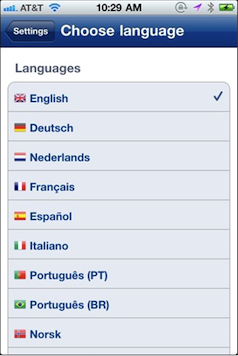
Lesson 3: Be Careful in Assuming Which Languages Travelers Prefer
Websites increasinly use backend technologies such as geolocation (IP detection) and language detection (the language preference of the user’s web browser) to make assumptions about a user’s location and language preference.
However, these tools can create problems when trying to make assumptions about travelers. One must assume that visitors to travel sites may be using many different web browsers or mobile devices, may be traveling outside of their home countries, or may be using shared computes, such as at foreign offices or at Internet cafés.
So it’s important that companies always make the visual global gateways easy to find and use so users can override any default language or country selections. Also, the notion of “country” also must be made clear. For instance, if a website asks users to select a country, users might wonder if it is referring to their home country, current country, or destination country.
As shown here, if a user with a web browser set to Spanish visits Tripadvisor.com, he sees the following banner at the top of the screen:
This banner asks if the user wishes to switch to the Spanish version of TripAdvisor. In addition, the user can make this the default language setting so return visits go straight to the Spanish-language interface.
TripAdvisor uses language detection to make users aware of the language options, while allowing them the freedom to opt in or not. This is a great way to not only create a positive user experience but also gain valuable information on the relative value of the Spanish-language content.
TripAdvisor also does an excellent job of supporting country codes (tripadvisor.de, tripadvisor.ca, etc.). A country code makes it possible to bypass the .com global gateway altogether.
Lesson 4: Global Consistency Improves Efficiency and Usability
Hotels.com, which is owned by Expedia, excels not only in languages (with support for 35) but also in its global consistency.
Shown here are three country websites, each leveraging the same core design. Such consistency is more efficient, as global templates can be developed and rolled out globally and can be managed with fewer resources. Consistency in logo placement, navigation, and architecture, can also improve global branding and trust.
Web users, particularly bilingual web users, frequently navigate between the .com site and the site for their country or language. Consistency saves users from having to relearn navigation along the way. And there is another aspect to this: localized sites often do not contain the same depth of content that the .com sites contain. Users often are aware of this and jump back and forth to get all the content they can find. Companies that embrace consistency can improve the experience for users who jump between sites.
Lesson 5: Always Manage Linguistic Expectations
Because users are well aware if a local website isn’t fully localized, why not be upfront about it?
Hyatt’s global gateway deserves mention, shown here on the right. First note the map icon at the top, which makes the gateway easy to find, regardless of the user’s language.
The available languages are presented in their native languages, an important best practice. Hyatt also does something that few companies seem willing to do: they’re honest with the user about the degree of language support on their website.
The Russian and Portuguese sites are labeled as “abridged” sites—a nice way to manage user expectations. It’s refreshing to see a company tell users when a site is not fully localized. After all, users will figure this out on their own soon enough. By being upfront about it, you will develop a more credible image with your customers.
Lesson 6: When Looking at Web Localization ROI, Look Beyond Revenue
Calculating the return on investment (ROI) for web localization can be challenging; there is often a fair amount of guesswork involved. But always be sure to look beyond direct revenue when calculating ROI. A localized website can pay many dividends beyond direct sales.
For example, a recent Wall Street Journal article noted that Starwood Hotels was offering hotel amenities specifically tailored to Chinese travelers. This program was a result of data gathered from an influx of Chinese subscribers to Starwood’s loyalty program. Starwood learned that language support was one of the key factors that Chinese travelers used when selecting a hotel.
To gather this information, Starwood first needed a localized website so that Chinese users could sign up for a loyalty program in the first place. And Starwood began localizing for Chinese travelers in 2007.
Web localization isn’t just about direct sales, it’s also about lead generation. And it’s about learning what your customers, and future customers, want.
Without a localized website, you’re just guessing.
To Learn More
For much more on travel industry websites, download the free research report: The Best Global Travel Web Sites at www.lionbridge.com/travel (registration required). The report is authored by John Yunker and sponsored by Lionbridge.


